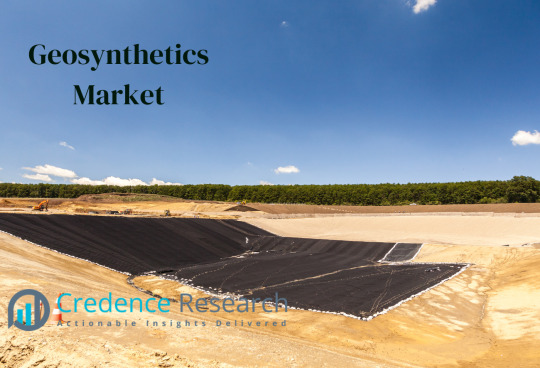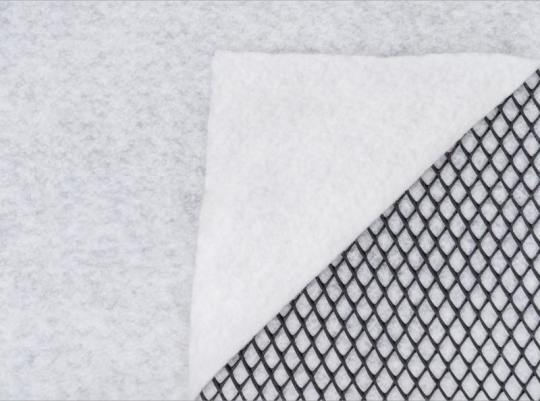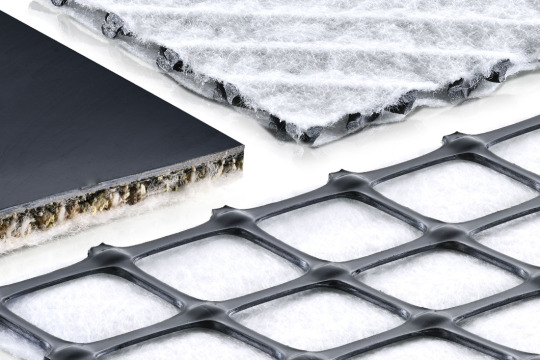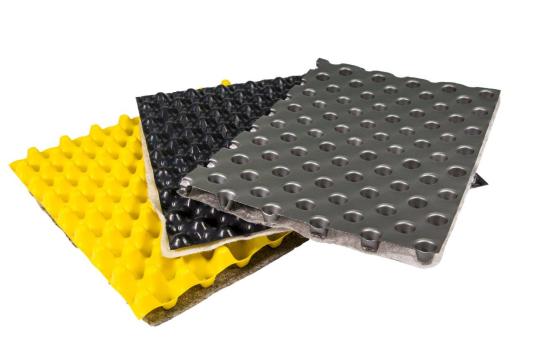#geocomposites
Text
Elevate Civil Engineering with Indonet's Geocomposite Solutions

Unlock the potential of your civil engineering projects with Indonet's innovative geocomposite solutions. From soil reinforcement to effective erosion control, our advanced products are designed to boost durability and performance. Discover how Indonet can transform your construction efforts and take your projects to the next level.
#Indonet#IndonetGroup#geocomposites#saltbarriers#indodrainsaltbarriers#geotextile#indokoncoirgeotextile#geonetmanufacturer#geocell#indokongeocell#dimpleboards#indokondimpleboards
0 notes
Text
Geocomposites Market Outlook: Geotechnical Engineering and Environmental Stewardship

Geocomposites Market Full Information:
Geocomposites are advanced materials designed to address various challenges in geotechnical and civil engineering applications. These materials typically consist of a combination of geotextiles, geogrids, and/or geomembranes, which are layered or combined to provide improved mechanical and hydraulic properties. Geocomposites play a crucial role in various construction and environmental projects, contributing to their durability and effectiveness.
In the market overview and scope, geocomposites have witnessed significant growth due to their versatile applications across multiple industries. They are extensively used in soil stabilization, erosion control, drainage systems, and landfill engineering, among other applications. The market scope extends to infrastructure development, environmental protection, and geotechnical engineering, making it a dynamic and evolving sector.
Geocomposites market growth in the industry is driven by several factors. Increasing infrastructure development, particularly in emerging economies, has heightened the demand for geocomposites. Their use in road construction, railways, and hydraulic engineering projects has surged, promoting market expansion. Additionally, growing environmental concerns and the need for sustainable solutions have further fueled the adoption of geocomposites in landfills, wastewater treatment, and erosion control initiatives.
The geocomposites industry comprises various players, including manufacturers, suppliers, and distributors. Competition in this sector is intense, with companies continuously innovating to improve the performance and sustainability of their products. Market players often focus on developing custom geocomposites to cater to the specific needs of different projects, enhancing their market presence and reputation.
In terms of trends, the geocomposites market is witnessing a shift towards eco-friendly and recyclable materials. Sustainability has become a key driver, with consumers and project developers preferring environmentally responsible solutions. This has led to the development of geocomposites that use recycled materials and are designed for easy disposal or reuse, aligning with circular economy principles.
Furthermore, the integration of advanced technologies, such as geosynthetics with monitoring systems, is gaining prominence. These smart geocomposites can provide real-time data on structural integrity and environmental conditions, offering a new dimension to project management and maintenance. Such innovative solutions are likely to reshape the geocomposites market in the coming years.
In conclusion, the geocomposites market is a thriving industry that plays a crucial role in the fields of geotechnical and civil engineering. It offers versatile solutions for infrastructure development, environmental protection, and sustainability. As the industry continues to evolve, we can expect to see further advancements in material composition and technology integration to meet the growing demands of modern construction and environmental projects.
0 notes
Text
0 notes
Text
Drainage Geocomposite Specifications in Delhi NCR - Underground drainage: They are installed under roads, sports fields, and other structures to collect and channel water away from the surface, preventing stagnation and maintaining stability. Full and containment walls: drainage geocomposites Manufacturers and Suppliers in Delhi, India are used in health filling systems and behind the containment walls to manage leachate and groundwater, reducing hydrostatic pressure and improving the stability of the structures.
0 notes
Text
#geosynthetics#geogrid#businessenquiry#exportenquiry#geocosmetics#geotextiles#product#GeogridManufacturers#Geocell#GeocellManufacturers#Geonets#Geocomposite#Geofabric#Geosys#India#GeotextileManufacturers#GeosysIndia GeoSys India Infrastructures Pvt.Ltd.#construction#export#exportquality#businessEnquiry#highwayconstruction#highwayprojects
0 notes
Text
Unveiling the Impermeable Shield: Exploring the World of Geomembranes Materials - A Blog By IHR Insights

Introduction:
In the vast realm of civil engineering and environmental protection, there's a silent guardian beneath our feet – Geomembranes. These versatile materials play a crucial role in creating impermeable barriers, shielding the Earth from the impacts of various substances. In this blog, we embark on a journey to unravel the wonders of geomembranes materials, understanding their composition, applications, and the environmental benefits they bring to the table.
Understanding Geomembranes:
Geomembranes are synthetic membranes engineered for their impermeable properties. Typically made from high-density polyethylene (HDPE), low-density polyethylene (LDPE), polyvinyl chloride (PVC), or ethylene propylene diene monomer (EPDM), these materials serve as efficient barriers against liquids and gases. The choice of material depends on the specific requirements of the application, considering factors such as chemical resistance, flexibility, and durability.
Applications Across Industries:
Environmental Containment:
Geomembranes find extensive use in environmental containment systems, preventing the seepage of contaminants into soil and groundwater. Landfills, hazardous waste storage, and industrial ponds rely on geomembranes to create robust barriers that protect the surrounding environment.
Water Resource Management:
Water conservation and management are paramount in today's world. Geomembranes play a vital role in reservoirs, canals, and irrigation systems, preventing water leakage and ensuring efficient water distribution. Additionally, they are employed in wastewater treatment facilities to contain and control effluent.
Mining Industry:
In the mining sector, where the extraction and processing of minerals generate various byproducts, geomembranes act as liners for tailings ponds. These liners prevent the leaching of harmful substances into the soil and water, safeguarding ecosystems from potential contamination.
Aquaculture:
Geomembranes contribute to sustainable aquaculture practices by serving as pond liners. They create a reliable barrier that prevents the seepage of water, maintaining optimal water levels for aquatic life while protecting the surrounding environment.
Environmental Benefits:
Contamination Prevention:
Geomembranes act as a frontline defense against soil and water contamination, safeguarding ecosystems from the harmful effects of pollutants. This is particularly crucial in industries dealing with hazardous materials.
Resource Conservation:
By preventing water seepage in reservoirs and irrigation systems, geomembranes contribute to the efficient use of water resources. This is pivotal in regions facing water scarcity, promoting sustainable water management practices.
Landfill Management:
Geomembranes play a pivotal role in landfill management by containing leachate, the liquid that percolates through waste materials. This containment prevents the potential spread of pollutants into the surrounding soil and groundwater.
Innovation and Future Trends:
As technology advances, the field of geomembranes continues to evolve. Innovations such as geocomposite materials, which combine the benefits of geotextiles and geomembranes, offer enhanced performance and durability. The industry is also exploring biodegradable geomembranes, aligning with the broader global movement towards environmentally friendly solutions.
Read More from our latest study on Geomembranes Market report.
Conclusion:
In the grand tapestry of civil engineering, geomembranes stand as unsung heroes, silently but effectively guarding against environmental threats. As our understanding of environmental sustainability deepens, the importance of these impermeable barriers becomes increasingly apparent. From waste containment to water conservation, geomembranes play a pivotal role in shaping a more resilient and sustainable future for our planet.
– Analyst Team
IHR Insights
[email protected]
4 notes
·
View notes
Text
Geosynthetics Market Dynamics: Global Growth and Trends (2023-2032)
The geosynthetics market is projected to grow from USD 7,857.78 million in 2023 to USD 13,368.05 million by 2032, at a compound annual growth rate (CAGR) of 5.90%.
The geosynthetics market is a rapidly growing sector within the construction and environmental industries, driven by the need for innovative solutions in civil engineering, environmental projects, and sustainable construction practices. Geosynthetics, which include materials such as geotextiles, geomembranes, geogrids, geonets, and geocomposites, are used extensively to reinforce soil, manage erosion, facilitate drainage, and contain liquids in projects ranging from roadway construction to waste containment. The market's growth is fueled by the increasing recognition of these materials' cost-effectiveness, durability, and flexibility compared to traditional construction materials like concrete and steel.
Several factors contribute to the expansion of the geosynthetics market. There's a rising emphasis on infrastructure development across both developed and developing nations, where geosynthetics play a crucial role in ensuring the longevity and sustainability of structures. Environmental concerns also drive the adoption of geosynthetics, as they are essential in water conservation projects, landfill operations, and erosion control initiatives, which are increasingly governed by stringent regulations worldwide. The ongoing advancements in material technology, which enhance the functionality and application scope of geosynthetics, also push the market forward.
Geosynthetics are a category of synthetic products used to solve civil engineering problems. They are primarily made from polymeric materials and are used in a variety of applications including roads, airfields, railroads, embankments, retaining structures, reservoirs, canals, dams, erosion control, sediment control, and landfill liners. These materials have become an essential part of many infrastructure projects due to their functionality and cost-effectiveness.
The main types of geosynthetics include:
Geotextiles: These are permeable fabrics which, when used in association with soil, have the ability to separate, filter, reinforce, protect, or drain. They are typically made from polyester or polypropylene.
Geomembranes: These are impermeable membranes used primarily for liquid or vapor barriers. They are commonly used in landfill liners, canal liners, and in remediation projects to contain contamination.
Geogrids: These are geosynthetics formed by a network of integrally connected elements with openings large enough to allow interlocking with surrounding soil, rock, earth, and other surrounding materials. They are mainly used for reinforcement.
Geofoams: Lightweight, cellular polymeric materials used mainly as lightweight fill materials for construction where a lightweight solution is required, such as embankments over soft soils or behind retaining walls.
Geonets and Geocomposites: Geonets are used for drainage applications, consisting of a network of extruded polymer ribs. Geocomposites combine two or more geosynthetics types, such as geotextiles and geomembranes, to offer multiple functions (e.g., drainage and filtration).
Key Player:
AGRU Kunststofftechnik GmbH
Low & Bonar PLC
Tensar Corporation
Raven Industries, Inc.
Thrace Group
GSE Environmental Inc.
Officine Maccaferri S.p.A.
Koninklijke Ten Cate B.V.
HUESKER Synthetic GmbH
Solmax International Inc.
Geofabrics Australasia Pty. Ltd.
More About Report- https://www.credenceresearch.com/report/geosynthetics-market
Regional Insights:
North America: In North America, particularly the United States and Canada, the geosynthetics market is driven by stringent environmental regulations and the need for sustainable infrastructure. The emphasis on modernizing aging infrastructure and increasing investments in water management and road construction projects also boost demand. The region sees a high adoption rate of advanced geosynthetic products due to strong regulatory frameworks and the presence of leading market players.
Europe: Europe's market is characterized by high environmental awareness and strict regulations concerning construction and waste management. The European Union's policies on landfill management and coastal protection projects, along with the region's commitment to environmental sustainability, significantly contribute to the growth of the geosynthetics market. Northern European countries, with their focus on renewable energy projects, particularly highlight the use of geosynthetics for stabilizing and protecting installations.
Asia-Pacific: This region is the fastest-growing market for geosynthetics, driven largely by rapid urbanization and infrastructure development in countries like China, India, and Southeast Asian nations. The extensive ongoing and planned construction projects in transportation, real estate, and water conservation in these populous countries are key drivers. The market is also supported by favorable government policies aimed at improving infrastructure to boost economic growth.
Latin America: In Latin America, the market growth is influenced by the need for infrastructure improvement and mining activities. Countries like Brazil and Chile, which have significant mining industries, utilize geosynthetics for mine tailings management and erosion control. Additionally, governmental efforts to improve sanitation and flood management systems provide further impetus to the market.
Segments:
Based on Product Type:
Geotextile
Geomembrane
Geogrid
Geonet
Geocomposite
Geosynthetics Clay Liner
Others
Based on Material Type:
Polyethylene (HDPE/LLDPE)
Polypropylene (PP)
Polyester
Natural fibers
Others
Browse the full report – https://www.credenceresearch.com/report/geosynthetics-market
Browse Our Blog : https://www.linkedin.com/pulse/geosynthetics-market-report-opportunities-challenges-2023-2032-singh-k7vff
Contact Us:
Phone: +91 6232 49 3207
Email: [email protected]
Website: https://www.credenceresearch.com

0 notes
Text
Geosynthetic Materials in Modern Construction: Modern Uses & Benefits
In today's dynamic world of construction, geosynthetic materials have proven to be invaluable resources. Engineered to enhance the performance and longevity of various construction applications, these materials have brought about significant advancements in the industry. This article explores the multifaceted uses and advantages of geosynthetics, with a particular focus on their role in road construction and building projects.

Introduction to Geosynthetics
What are Geosynthetics?
Geosynthetics are synthetic materials specially manufactured for use in civil engineering, environmental, and construction projects. These engineered materials offer a wide range of properties and applications that contribute to the strength, stability, and sustainability of construction projects.
Geosynthetics in Road Construction
Overview and Applications
In road construction, geosynthetics have become indispensable for enhancing performance and durability. They are used for soil stabilization, base reinforcement, erosion control, and drainage, among other applications.
Geocells in Road Construction
Geocells are three-dimensional honeycomb-like structures that provide soil stabilization and load support. They are particularly effective in road construction over weak subgrades, reducing the risk of road deformation and failure.
Geogrid for Road Construction
Geogrids, with their grid-like structure, are used for soil reinforcement. They are essential in reinforcing the road base, improving load-carrying capacity, and extending the lifespan of roads.
Use of Geosynthetics in Road Construction
The use of geosynthetics in road construction enhances soil properties and aids in overcoming challenges like unstable soil, poor drainage, and high maintenance costs.
Benefits of Geosynthetic Materials in Construction
Enhanced Durability and Strength
Geosynthetic materials significantly increase the durability and load-bearing capacity of roads. This leads to a reduction in road damage and extends the overall lifespan of the construction.
Cost-Effectiveness
By improving soil stability and strength, geosynthetics reduce the need for traditional, more expensive construction materials like aggregates. This results in cost savings both in the short and long term.
Environmental Sustainability
Geosynthetics offer an environmentally friendly solution in construction. Their use minimizes the disturbance of natural soil layers and reduces the need for non-renewable resources.
Adaptability and Versatility
These materials are adaptable to a variety of soil types and construction conditions. Their versatility makes them suitable for a wide range of applications beyond road construction, including railways, landfills, and water containment systems.
Challenges and Considerations
Technical Expertise
The installation and utilization of geosynthetic materials require specialized knowledge and technical expertise. Proper installation is crucial for maximizing their effectiveness.
Quality and Standards
Maintaining high quality and adherence to standards is essential for the optimal performance of geosynthetic materials. This underscores the importance of choosing reliable and experienced manufacturers.
The Future of Geosynthetics in Construction
Innovations and Developments
The future of geosynthetics in construction is bright, with ongoing research and development. Innovations in material science and technology are continuously enhancing the capabilities and applications of geosynthetic materials.
In conclusion, geosynthetic materials have played a pivotal role in revolutionizing modern construction practices. As the industry continues to evolve, these engineered materials will remain at the forefront of innovation and sustainability.
Introducing Indonet Group
As a leading geosynthetics manufacturer based in Vadodara, India, Indonet Group offers a comprehensive product lineup that includes Indodrin geocomposites, Indian Geocell, Indo Drain geonets, and more. With a commitment to quality and innovation, Indonet Group continues to contribute to the advancement of the construction industry through the use of geosynthetic materials.
#Geotextiles#geosynthetic materials#indonetgroup#indonet#Geocell#geonets#Geocomposite#Salt Barriers#Dimple Boards
0 notes
Text
Geocomposites Market Size, Emerging Trends, Segmentation, Different Countries and Business Opportunities 2023 to 2030

Geocomposites are composite materials used in geotechnical engineering applications. They are typically made up of two or more geosynthetic materials that are combined to achieve specific performance characteristics.
Geocomposites can be designed for a variety of functions, such as drainage, filtration, separation, reinforcement, and erosion control. For example, a drainage geocomposite may be made up of a geotextile layer on top of a drainage core made of a geonet or geospacer. The geotextile layer prevents soil particles from clogging the drainage core while allowing water to pass through, and the drainage core provides a path for water to flow.
Some common types of geocomposites include:
1. Geotextile/geonet composites: These are used for drainage and separation applications.
2. Geotextile/geogrid composites: These are used for reinforcement applications.
3. Geotextile/geomembrane composites: These are used for containment and waterproofing applications.
4. Geotextile/woven geotextile composites: These are used for filtration and stabilization applications.
Geocomposites offer several advantages over traditional geotechnical materials, such as reduced installation time and costs, improved performance, and increased durability. They are widely used in a variety of civil engineering applications, including road construction, landfills, and retaining walls.
The market growth is primarily driven by the increasing demand for geocomposites in various applications, such as road construction, water management, and waste management. The growing awareness about the benefits of geocomposites, such as improved durability, reduced installation time and cost, and improved performance, is also driving the market growth.
Among the different types of geocomposites, the geotextile/geonet composites segment is expected to hold the largest share of the market during the forecast period, due to their wide range of applications in drainage and separation functions. Geocomposites are also used in reinforcement, containment, and erosion control applications.
Major players operating in the global geocomposites market include, GSE Environmental, Officine Maccaferri Spa, Huesker Synthetics GmbH, Thrace Group, SKAPS Industries, Leggett & Platt, Inc., Hans Geo Components, TenCate Geosynthetics, ABG Ltd, ABG Ltd, Terram Geosynthetics Pvt. Ltd., Tenax, and HUESKER Inc.
The demand for geocomposites in the market is driven by several factors. One of the main factors is the increasing infrastructure development activities, which require durable and sustainable materials for various applications. Geocomposites are used in road construction, railways, airports, landfills, and other infrastructure projects, as they offer a range of benefits such as improved performance, reduced installation time, and cost-effectiveness.
Another factor driving the demand for geocomposites is the growing awareness about their benefits in various applications. For example, geocomposites are widely used for drainage and erosion control in civil engineering projects, as they can help to prevent soil erosion and improve water flow. They are also used for filtration and stabilization, as they can help to improve soil quality and prevent soil contamination.
The demand for geocomposites is also driven by the increasing emphasis on environmental protection and sustainability. Geocomposites are eco-friendly materials that can be recycled and reused, reducing the environmental impact of infrastructure projects. In addition, the use of geocomposites can help to reduce the need for traditional materials such as gravel, sand, and stone, which can be environmentally damaging.
One of the main drivers of market growth is the increasing demand for geocomposites in infrastructure development projects. Geocomposites are used in a wide range of infrastructure projects, including roads, railways, airports, and landfills, as they offer various benefits such as durability, improved performance, and reduced installation time and cost.
Another driver of market growth is the increasing emphasis on environmental protection and sustainability. Geocomposites are eco-friendly materials that can be recycled and reused, reducing the environmental impact of infrastructure projects. The use of geocomposites can also help to reduce the need for traditional materials such as gravel, sand, and stone, which can be environmentally damaging.
The market is also expected to benefit from technological advancements in geocomposites, such as the development of new materials and composites that offer improved performance and durability. In addition, the increasing use of geocomposites in various applications, such as drainage, erosion control, and filtration, is expected to drive market growth.
Geocomposites have a wide range of applications in the construction and infrastructure industries. Some of the most common applications of geocomposites include:
◘Drainage: Geocomposites are widely used for drainage applications in various infrastructure projects, such as roadways, railways, and airports. They are designed to allow water to flow through while filtering out soil particles, preventing clogging and improving water flow.
◘Filtration: Geocomposites are used for filtration applications in geotechnical and environmental engineering projects. They are designed to prevent the migration of fine soil particles while allowing water to pass through.
◘Separation: Geocomposites are used to separate different soil layers, preventing the mixing of dissimilar materials and maintaining their structural integrity.
◘Erosion control: Geocomposites are used to prevent soil erosion and protect slopes from landslides. They can also be used to stabilize soil, preventing soil erosion and improving the stability of slopes.
◘Reinforcement: Geocomposites are used to reinforce soil structures, such as retaining walls, embankments, and foundations. They can provide additional strength and stability to the soil, helping to prevent failure.
◘Containment: Geocomposites are used for containment applications in environmental engineering projects, such as landfills, mining sites, and waste storage facilities. They are designed to prevent the migration of hazardous materials and contaminants into the surrounding environment.
Overall, geocomposites are versatile materials with a wide range of applications in the construction and infrastructure industries. They are used to improve the performance and durability of various infrastructure projects, while also promoting environmental sustainability.
0 notes
Text
Geocomposites Market Growth: Exploring Market Dynamics and Opportunities

Geocomposites, a term derived from "geosynthetic composites," refer to engineered materials comprising two or more geosynthetic components combined to create a single product with specific functions and properties. These materials are primarily utilized in various civil engineering and environmental applications. Geocomposites play a pivotal role in modern construction and infrastructure development due to their versatility and ability to enhance the performance of geotechnical systems.
The geocomposites market has witnessed substantial growth in recent years, driven by the increasing need for sustainable and cost-effective solutions in the construction and environmental sectors. These materials are designed to address challenges related to soil stabilization, erosion control, drainage, and reinforcement, among others. Geocomposites offer superior durability and longevity, making them a preferred choice for many infrastructure projects.
The geocomposites market has been characterized by steady growth, largely attributed to the expanding construction and infrastructure development activities worldwide. As governments and private sectors invest in upgrading and expanding transportation networks, water management systems, and environmental protection measures, the demand for geocomposites continues to rise. This market is also closely linked to the global emphasis on sustainability, as geocomposites help reduce the environmental impact of construction and land development projects.
Within the geocomposites market industry, several key trends have emerged. Firstly, there is a growing focus on the development of innovative products that address specific challenges encountered in various applications. Manufacturers are investing in research and development to create geocomposites with enhanced properties, such as improved filtration, increased strength, and better resistance to chemical and biological degradation. Additionally, the integration of digital technologies and data-driven solutions is gaining traction, providing engineers and designers with valuable insights for optimizing geocomposite usage in different projects.
Moreover, the geocomposites market is witnessing regional variations in demand and applications. While developed regions like North America and Europe have been early adopters of these materials, emerging economies in Asia-Pacific and Latin America are increasingly recognizing their benefits. As urbanization and infrastructure development continue to surge in these regions, the geocomposites market is poised for substantial growth.
In conclusion, the geocomposites market is experiencing steady expansion, driven by the need for sustainable and efficient solutions in construction and environmental projects. The industry is marked by ongoing innovation and a focus on enhancing product performance, making geocomposites an integral part of modern infrastructure development and environmental protection efforts worldwide.
0 notes
Text
https://geosyntheticsystems.ca
Geosynthetic materials, offered by companies like Geo-Synthetic Systems (GSS), have become indispensable in various civil engineering, construction, and environmental projects due to their versatility, durability, and cost-effectiveness. Here's a closer look at the wide range of applications where geosynthetic materials are utilized effectively. With a focus on quality, reliability, and sustainability, GSS offers a diverse portfolio of geosynthetic materials designed to meet the unique requirements of each project. Their product range includes geotextiles, georgics, geomembranes, geocomposites, and other specialized geosynthetic solutions.
More info visit Website : https://geosyntheticsystems.ca
#Geotextiles#Gabion Baskets#Landscape Supplies#Landscape Edging#Pond Liner#Landscape Fabrics#Permeable Paving#Window Wells#Drainage Solutions
0 notes
Text
Drainage filtration using geocomposites to prevent silt and soil particles from clogging pipes or raising friction levels. Geocomposites are made up of a geonet and a synthetic needle-punched geotextile that are joined together with heat.
0 notes
Text

HDPE Liner Geomembrane Manufacturers in India Geosys India is one of the Best leading Indian Manufacturer, Supplier and Exporter of Geosynthetic Products like Uniaxial and biaxial geogrids, Geocomposite, Geotextile, Geonets, Geofabric, Geo-cell, Geomembrane & Geotubes.
#geosynthetics#geogrid#businessenquiry#exportenquiry#geocosmetics#geotextiles#product#GeogridManufacturers#Geocell#GeocellManufacturers#Geonets#Geocomposite#Geofabric#Geosys#India#GeotextileManufacturers#GeosysIndia#GeoSysIndiaInfrastructurePvtLtd.#construction#export#exportquality#businessEnquiry#Rewall#highwayconstruction#highwayprojects
0 notes
Text
10 Ways for Slope Protection & Stabilization
Slopes, whether natural or man-made, are a ubiquitous feature of our landscapes. However, they can be susceptible to erosion, landslides, and other failures. This can create safety hazards, damage infrastructure, and disrupt natural ecosystems.
Fortunately, a variety of Slope Stabilization Solutions exist to ensure the stability and longevity of slopes.
Let's explore ten effective methods:
1. Vegetation and Bioengineering: Planting native grasses, shrubs, and trees on slopes helps bind soil particles together, reducing erosion. This natural approach also promotes habitat creation and aesthetics.
2. Geosynthetic Reinforcements: These include geotextiles, geogrids, and geocomposites – synthetic materials placed within the soil to increase its strength and stability.
3. Terracing and Grading: Creating terraces (stepped sections) or modifying the slope's angle reduces the overall inclination and gravitational forces, enhancing stability.
4. Retaining Walls: Constructed walls made of concrete, masonry, or steel can physically support and retain soil on steep slopes.
5. Soil Nailing: This technique involves installing closely spaced grouted nails into the slope to reinforce the soil and prevent movement.
6. Shotcrete: A sprayable concrete applied to the slope face creates a protective layer that binds soil particles and strengthens the surface.
7. Gabion Walls: Flexible and robust walls constructed from interlocking wire mesh baskets filled with stones offer strong erosion and slope protection. Explore companies like gabion wire mesh manufacturers in India like Shrisai for high-quality options.
8. Drainage Systems: Proper drainage controls are crucial. Ditches, channels, and perforated pipes help divert excess water away from slopes, preventing saturation and potential landslides.
9. Biodegradable Mats: These temporary biodegradable mats made from natural materials like jute or coir help hold soil in place during the initial establishment of vegetation on slopes.
10. Ground Improvement Techniques: Techniques like compaction, grouting, or chemical stabilization can improve the properties of weak soils and enhance their overall stability.
Choosing the Right Slope Stabilization Solution
The optimal slope stabilization method depends on various factors: slope angle, soil type, budget, and environmental considerations. Consulting a qualified geotechnical engineer helps determine the most effective and sustainable solution for your specific needs.
The Importance of Slope Stabilization
Implementing Slope Stabilization Solutions offers numerous benefits:
Safety: Reduces the risk of landslides and protects infrastructure and property from damage.
Erosion Control: Minimizes soil erosion, maintaining land integrity and preventing sedimentation in waterways.
Aesthetics: Stabilized slopes can be visually appealing, especially when incorporating natural elements like vegetation.
Environmental Benefits: Slope stabilization contributes to healthy ecosystems by promoting vegetation growth and preventing soil loss.
Slope stabilization is crucial for ensuring the safety and integrity of our landscapes. By understanding the various methods available and consulting with professionals, you can find the most effective solution to secure your slopes and promote a healthy environment.
#gabion manufacturer#gabion exporters#gabion walls#Rockfall Protection & Mitigation#Slope Stabilization Solutions#Shri Sai Eco Solutions
0 notes